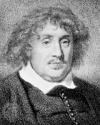Bibliography
In 1631, he published a poem on the subject of David and Bathsheba, entitled David's Heinous Sinne, Heartie Repentance, Heavie Punishment. At Broadwindsor he compiled The Historie of the Holy Warre (1639), a history of the crusades, and The Holy State and the Prophane State (1642). This work describes the holy state as existing in the family and in public life, gives rules of conduct, model "characters" for the various professions and profane biographies. It was perhaps the most popular of all his writings. His first published volume of sermons appeared in 1640 under the title of Joseph's party-coloured Coat.
Engraved title page of the third edition of Historie of the Holy Warre by Thomas Fuller, 1647Lionel Cranfield, 3rd Earl of Middlesex, who lived at Copt Hall, near Waltham, gave him what remained of the books of the lord treasurer his father; and through the good offices of the marchioness of Hertford, part of his own pillaged library was restored to him. Fuller was thus able to prosecute his literary labours, producing successively his descriptive geography of the Holy Land, called A Pisgah-Sight of Palestine (1650), and his Church-History of Britain (1655), from the birth of Jesus Christ until the year 1648.
With the Church-History was printed The History of the University of Cambridge since the Conquest and The History of Waltham Abbey. These works were furthered by his connection with Sion College, London, where he had a room. The Church History was angrily attacked from the high-church side by Peter Heylin. At the Oxford Act of 1657, Robert South, who was Terrae filius, lampooned Fuller, whom he described in this Oratio as living in London, ever scribbling and each year bringing forth new folia like a tree. At length, continues South, the Church-History came forth with its 166 dedications to wealthy and noble friends; and with this huge volume under one arm, and his wife (said to be little of stature) on the other, he ran up and down the streets of London, seeking at the houses of his patrons invitations to dinner, to be repaid by his dull jests at table. His last and best patron was George Berkeley, 1st Earl Berkeley (1628–1698), of Cranford House, Middlesex, whose chaplain he was, and who gave him Cranford rectory (1658). To this noble-man Fuller's reply to Heylyn's Examen Historicum, called The Appeal of Injured Innocence (1659), was inscribed. In An Alarum to the Counties of England and Wales (1660) Fuller argued for a free and full parliament—free from force, as he expressed it, as well as from abjurations or previous engagements. Mixt Contemplations in Better Times (1660), dedicated to Lady Monk, tendered advice in the spirit of its motto, "Let your moderation be known to all men: the Lord is at hand."
His sense of humour kept him from extremes. "By his particular temper and management," said Laurence Echard in his History of England, "he weathered the late great storm with more success than many other great men." He was known as "a perfect walking library." Antithetic and axiomatic sentences abound in his pages.. "Wit," wrote Coleridge after reading the Church History, "was the stuff and substance of Fuller's intellect". Charles Lamb made some selections from Fuller, and admired his "golden works."






